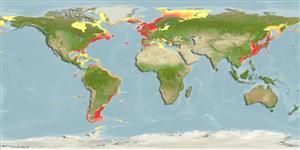Common names from other countries
Classification / Names / Names
Nombres comunes | Sinónimos | Catalog of Fishes (gen., sp.) | ITIS | CoL | WoRMS
Environment: milieu / climate zone / depth range / distribution range
Ecología
; salobre; rango de profundidad 0 - 590 m (Ref. 415). Tropical
Distribución
Países | Áreas FAO | Ecosistemas | Ocurrencias, apariciones | Introducciones
Northwest Pacific, Atlantic Ocean, Mediterranean, Antarctic and Arctic Ocean: Iberian Peninsula and Belize. Tropical and subtropical.
Length at first maturity / Tamaño / Peso / Age
Maturity: Lm ? range ? - ? cm Max length : 3.0 cm TL macho / no sexado; (Ref. 415)
Found in rock crevices, mangrove root mats and mud, along subtidal and intertidal zones in marine and brackish environments (Ref. 415). Known to be an osconformer, which is unaffected by large and repeated changes in salinity, but is known to be affected by increases in water temperature (Ref. 86624). Known as a benthic species (Ref. 85346). Intertidal to 590 m in rock crevices; mangrove roots mats and mud (Ref. 415); 34 to 500 m both in Ionian and North Aegean Sea (Ref. 775). Infaunal, burrows (Ref. 116123). This species is collected from mangrove and Thalassia root mats (Ref. 86591).
Collin, R., M.C. Díaz, J. Norenburg, R.M. Rocha, J.A. Sánchez, M. Schulze, A. Schwartz and A. Valdés. 2005. (Ref. 415)
IUCN Red List Status (Ref. 130435)
CITES status (Ref. 108899)
Not Evaluated
Not Evaluated
Human uses
| FishSource |
Herramientas
Más información
Nombres comunesSinónimosDespredadoresReproducciónMadurezPuestaFecundidadHuevosEgg development
Age/Size
Crecimiento
Length-weight
Length-length
Morfología
Larva
Abundancia
Fuentes de Internet
Estimates based on models
Preferred temperature
(Ref.
115969): 3.4 - 22, mean 8.5 (based on 1568 cells).
Vulnerability
Low vulnerability (10 of 100).
Price category
Unknown.
